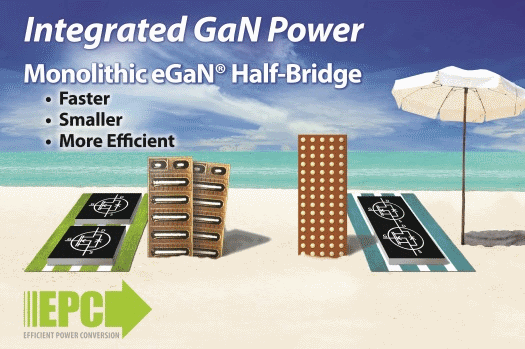The EPC2100 enhancement mode gallium nitride (eGaN) half-bridge transistor from Efficient Power Conversion (EPC) is the next step and the first of its kind power device for faster, more efficient designs than silicon technology. It is the first integrated circuit built on EPC’s eGaN process. This process was designed for making discrete enhancement mode gallium nitride-on-silicon power devices. As such, EPC’s design team led by co-founder, Joe Cao, needed to develop additional processes that could isolate the various high-voltage devices on a single chip. The goal was to make a process that could block high voltage and accommodate future integration of many components (EPC intends to launch a series of IC products over the next few years that use this new process). Process development, however, is only a small fraction of the effort needed to launch a product as advanced as the monolithic half-bridge. EPC’s product engineering team, under the leadership of Alana Nakata, needed to develop completely different chip-scale packaging and production testing techniques to ensure they could deliver a chip-scale IC with flawless quality. The applications engineering team, including Johan Strydom and David Reusch, worked in parallel to make certain the die layout would provide maximum performance benefit at minimum cost to customers. They then had to build sample circuits and test them to make sure they could deliver on the promise of a state-of-the-art power switching IC. Taken individually, each of these challenges may seem straightforward, but they all needed to be attacked in parallel and in a very coordinated way.
 The EPC2100 eGaN half-bridge transistor is the first of its kind and switches at 1/10 the time of a power MOSFET.
The EPC2100 eGaN half-bridge transistor is the first of its kind and switches at 1/10 the time of a power MOSFET.
The newly developed eGaN half-bridge converters switch in about one-tenth the time of a power MOSFET and increase efficiency and power density for complete buck converter systems approaching 93% at 10 A, and 90.5% at 25 A when switching at 500 kHz and converting from 12 to 1.2 Vdc. The increased speed didn’t come without challenges. All that increased speed can lead to increased parasitic inductance and that limits performance. So the EPC team led by Johan Strydom and David Reusch worked with Joe Cao to develop a product that would meet the need for higher system switching speeds by cutting the parasitic inductances in half, while reducing the size needed for the power stage, and the cost of assembling multiple components. EPC’s team executed this entire project in 6 months and the results are beyond their expectations.
Advertisement
Learn more about Efficient Power Conversion (EPC)





